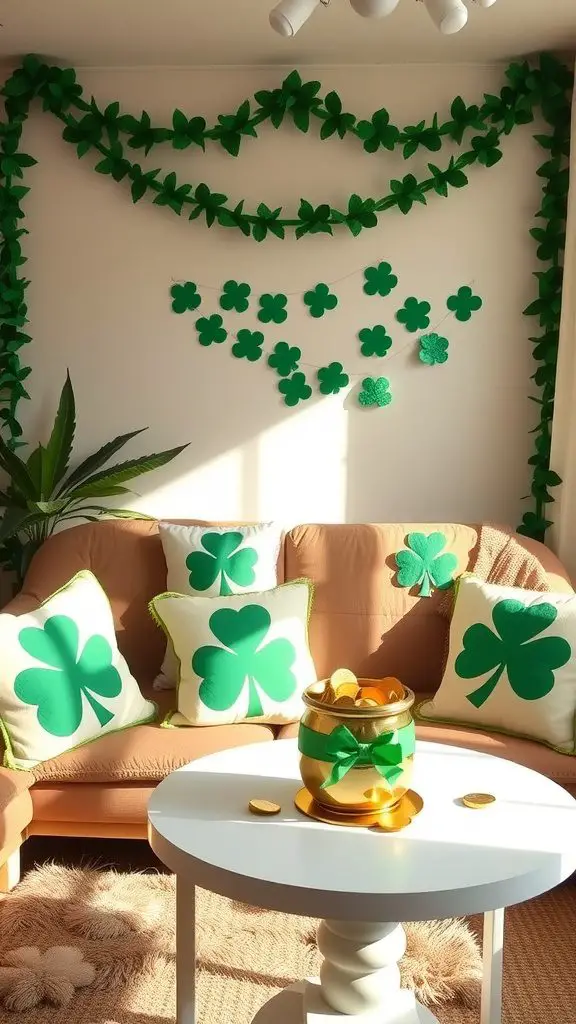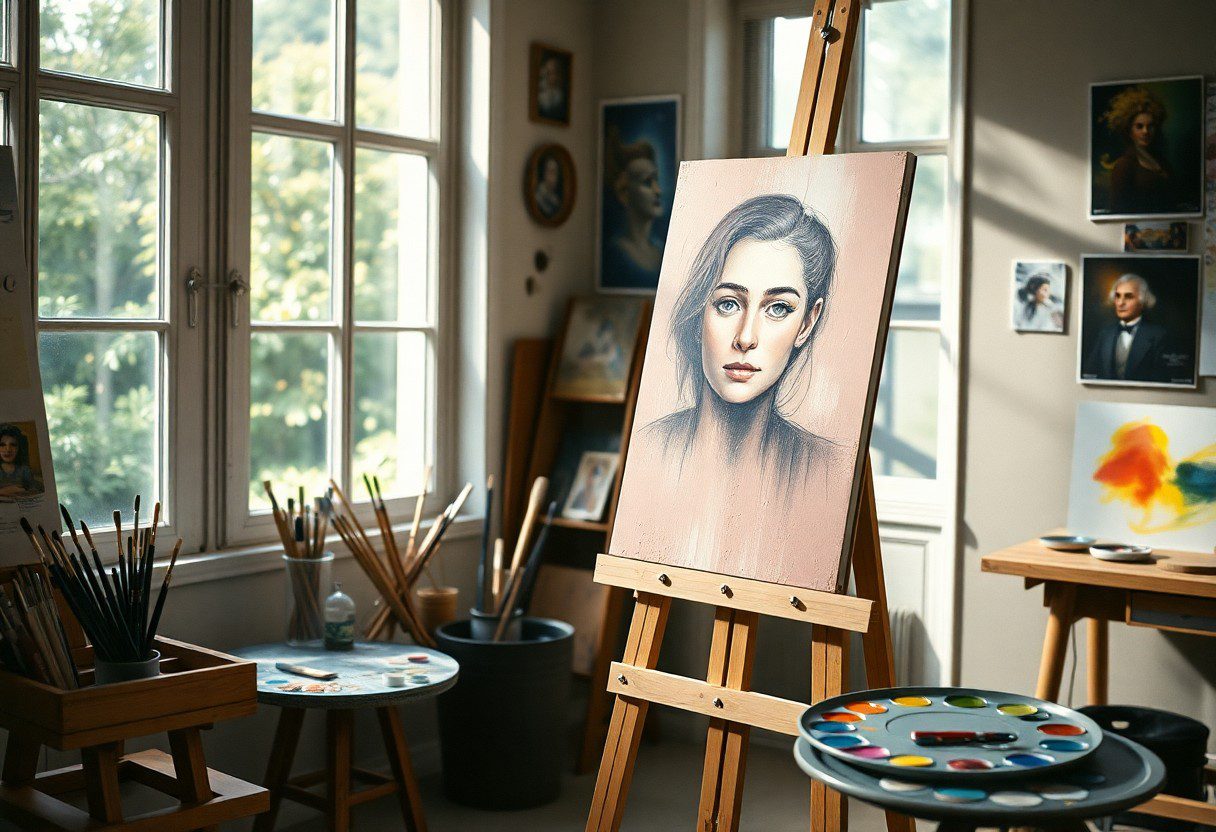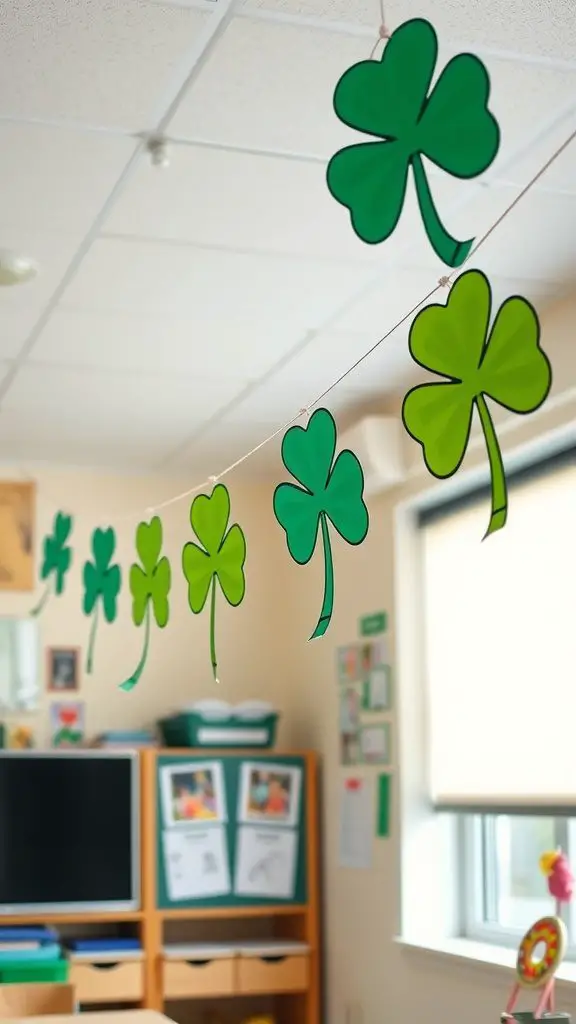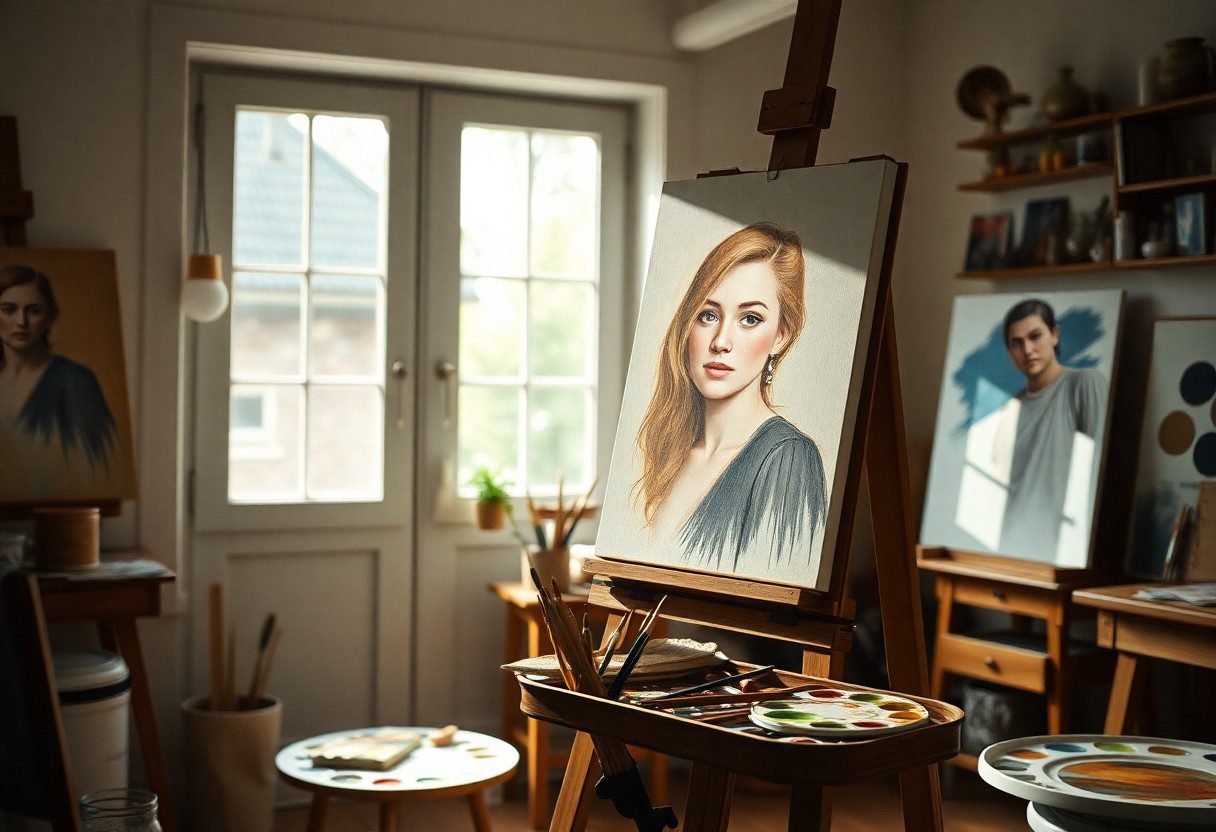Painting a compelling portrait requires more than just skill; it involves a well-structured approach to transform your vision into reality. In this step-by-step guide, you will explore each phase of the portrait painting creative process, from initial concept and composition to the final brushstrokes and finishing touches. By following these imperative steps, you’ll enhance your artistic abilities and create stunning portraits that capture the essence of your subjects. Prepare to elevate your painting experience as you begin on this transformative journey.
Understanding Portrait Painting
To explore into portrait painting, you must first grasp its foundational elements. Portrait painting is not merely about replicating a subject’s likeness; it’s about capturing their essence and personality, allowing the viewer a glimpse into their soul. As you progress in your creative journey, understanding the nuances of this art form will enrich your techniques and deepen your engagement with subjects.
Types of Portraits
To classify the diverse forms of portrait painting, you can explore several distinct types:
- Traditional Portraits
- Environmental Portraits
- Self-Portraits
- Abstract Portraits
- Candid Portraits
Assume that each type offers its unique approach to expressing character and emotion, enhancing the overall impact of your artwork.
| Type | Description |
| Traditional Portraits | Focus on the subject, often in a posed or formal manner. |
| Environmental Portraits | Emphasize the subject in their surroundings, showcasing their personality. |
| Self-Portraits | Allow artists to explore their identity and emotions through their own image. |
| Abstract Portraits | Utilize non-representational techniques to convey emotional depth. |
| Candid Portraits | Capture subjects in spontaneous, unposed moments. |
Key Factors in Portrait Art
On your journey to mastering portrait painting, you will encounter several key factors that influence your artistic expression. First, consider the importance of light and shadow, which add depth and realism to your work. Additionally, proportions and anatomy are crucial in achieving a convincing representation. Understanding color theory will help you create moods and emotions, while composition guides the viewer’s eye within your painting. Lastly, communication skills enable you to connect with your subjects, enhancing their portrayal.
- Light and Shadow
- Proportions and Anatomy
- Color Theory
- Composition
- Communication Skills
Knowing how these elements interact will enhance your ability to create compelling portraits that resonate with viewers.
The interplay of these factors creates a dynamic environment for innovative expression in your portrait painting. Embrace the use of light and shadow to evoke emotion; mastering proportions will ensure your subjects resonate with authenticity. Understanding color theory can enhance the emotional impact of your work, while solid composition skillfully directs the viewer’s gaze. Lastly, honing your interpersonal communication with subjects fosters an atmosphere conducive to revealing their true selves.
- Dynamic Use of Light
- Accurate Proportions
- Emotional Color Theory
- Effective Composition
- Interpersonal Communication
Knowing how to apply these factors will empower your artistic journey and elevate your portrait paintings.
The Step-by-Step Creative Process
One effective way to tackle portrait painting is to break down the process into manageable steps. This approach allows you to focus on each phase, ensuring that your artwork evolves smoothly and seamlessly. Below is a structured outline that encapsulates the primary stages you’ll encounter in your portrait painting journey.
| Step | Description |
| 1. Preparation | Gather references and tools. |
| 2. Sketching | Create a basic outline of the portrait. |
| 3. Underpainting | Establish the color palette and values. |
| 4. Detailing | Add finer details and textures. |
| 5. Finishing Touches | Refine and complete the portrait. |
Preparation and Planning
There’s a great deal of value in thorough preparation before you begin painting. Start by gathering your reference materials, including photos or sitting models. Also, take the time to set up your workspace, ensuring you have all the necessary tools and materials at hand. Proper planning helps you visualize the end result and can significantly enhance your painting experience.
Execution and Techniques
One of the most exciting parts of painting is the execution phase, where your vision begins to take form. At this stage, you will apply various techniques, such as layering, glazing, and blending colors to create depth and realism in your portrait. Taking care to focus on your brush strokes and color application is important for achieving a lifelike representation.
Another important technique to consider is the use of light and shadow. By strategically placing highlights and dark areas, you can create a sense of three-dimensionality that brings your portrait to life. Don’t hesitate to experiment with different brush types and paint mediums, as they can yield various textures and effects. Engaging with these techniques thoughtfully will enable you to master the intricacies of portrait painting.
Tips for Successful Portrait Painting
Clearly, mastering portrait painting requires practice and the right techniques. Here are some tips to help you achieve success in your portrait work:
- Study facial anatomy to understand structure.
- Use reference images for accuracy.
- Practice capturing expressions and emotions.
- Experiment with different materials and tools.
- Be patient and allow yourself time to improve.
Assume that every mistake is a learning opportunity in your artistic journey.
Color and Composition
Portrait painting demands a keen understanding of color relationships and visual arrangement. You should focus on selecting a harmonious palette that reflects the subject’s personality. Additionally, consider the arrangement of elements within the frame to direct the viewer’s attention to the focal point—the subject’s face—while complementing their features with surrounding colors and shapes.
Light and Shadow
An effective portrait relies heavily on the interplay of light and shadow to create depth and dimension. You want to observe how light falls on your subject’s face, highlighting certain areas while casting others in shadow. This contrast can add realism and emotion, contributing to the overall impact of your artwork.
A good understanding of light and shadow can transform your portrait from flat to lifelike. You can practice this by studying how shadows delineate facial features like cheekbones and jawlines, as well as how light can bring focus to the eyes. By establishing a light source, you guide the viewer’s eyes and evoke a mood that reflects your subject’s personality, ultimately enriching your painting with a more dynamic and engaging presence.
Pros and Cons of Different Approaches
Now, understanding the pros and cons of different painting approaches can enhance your decision-making process in portrait creation. Below is a breakdown that highlights the advantages and disadvantages of various techniques:
| Approach | Pros | Cons |
|---|---|---|
| Traditional Techniques | Rich texture and depth | Time-consuming, requires more materials |
| Modern Techniques | Innovative, often quicker results | Can lack depth compared to traditional methods |
| Digital Methods | Easy to edit and adjust | Can feel less personal, requires tech skills |
| Acrylics | Quick drying time | Less blending ability compared to oils |
| Oils | Superior blending and richness of color | Long drying time, can be more expensive |
| Watercolors | Fresh and luminous effects | Harder to control, can lack detail |
| Mixed Media | Versatile and unique results | Can be complex and unpredictable |
| Charcoal | Strong contrast, easy to work with | Messy and can smudge easily |
| Pastels | Vivid colors and immediate application | Fragile, requires fixative to preserve |
| Encaustics | Unique texture and durability | Complex process, requires specific materials |
Traditional vs. Modern Techniques
The choice between traditional and modern techniques often depends on your artistic goals and preferences. Traditional methods, such as oil painting, offer a rich, textured finish and a timeless quality, while modern techniques, including acrylics or mixed media, provide innovative and expressive results. Experimenting with both can enrich your artistic repertoire and help you discover your unique style.
Digital vs. Traditional Media
An important distinction in art creation is between digital and traditional media. Digital painting allows for easy modifications, layers, and various effects, which can greatly streamline your creative process. In contrast, traditional media often provides a tangible connection to your art, with unique textures and nuances that can come from physical materials.
Another advantage of digital methods is the accessibility of tools and resources through software, which can enhance your experiments with color and composition. However, traditional media engages you in a hands-on process that fosters a deeper understanding of materials and techniques. Balancing both can offer you the freedom to express yourself in diverse ways while enriching your overall artistic growth.
Common Mistakes and How to Avoid Them
For many artists, mistakes during the painting process can lead to frustration and uninspired results. It’s imperative to identify these common pitfalls early on, so you can refine your technique and develop a more polished portrait. By recognizing these challenges and implementing strategies to overcome them, you will undoubtedly elevate your artwork and enhance your overall creative journey.
Overworking the Canvas
With each brushstroke, it’s tempting to continue refining and layering your paint indefinitely. However, overworking the canvas can result in a muddled appearance and loss of vibrancy. To avoid this, establish a point at which you will step back and evaluate your work, allowing yourself to embrace imperfections rather than striving for unattainable perfection.
Ignoring Anatomy and Proportions
To create a convincing portrait, a solid understanding of anatomy and proportions is necessary. Skipping this step often leads to unrealistic representations, detracting from the overall quality of your work.
This foundational knowledge helps you accurately depict features and maintain a natural balance within your composition. Spend time studying human anatomy and practicing proportion guidelines to gain confidence in your representations. By honing your skills in this area, you will create more lifelike portraits, making your work resonate with viewers and enhancing your artistic credibility.
Resources for Further Learning
Your journey into portrait painting can be enriched through various resources that provide deeper insights and techniques. Exploring books and online courses can enhance your skills, while engaging in art communities and workshops allows for practical experience and feedback from fellow artists.
Books and Online Courses
An array of books and online courses are available to guide you through the portrait painting process. Look for those that focus on techniques, color theory, and the psychology of portraiture to broaden your understanding and skills. Many reputable platforms offer structured courses that allow you to learn at your own pace.
Art Communities and Workshops
On the flip side, joining art communities and participating in workshops can provide you with invaluable hands-on experience. Art communities often offer critiques, inspiration, and a sense of camaraderie, while workshops allow for direct instruction from seasoned artists.
Courses in art communities typically feature opportunities for live demonstrations, peer feedback, and collaborative projects. Engaging with other creatives in these settings will not only challenge you but also inspire new ideas in your portrait painting journey. Networking with fellow artists can lead to future collaborations and further learning opportunities.
Summing up
Upon reflecting on the step-by-step guide to the portrait painting creative process, you have explored various techniques that will enhance your skills and deepen your understanding of portraiture. Each stage, from initial sketching to the final brush strokes, contributes to the overall outcome of your artwork. By following this structured approach, you will not only boost your confidence but also develop your personal style. Embrace the journey, keep experimenting, and let your artistic vision come to life through these imperative steps.
FAQ
Q: What are the initial steps to begin a portrait painting?
A: The first step in portrait painting involves selecting a subject, whether it’s a live model or a photograph. Next, gather your materials, including canvas, paints, brushes, and any other tools you need. Set up your workspace in a well-lit area. Take time to observe the subject, noting their features, expressions, and proportions, before sketching a light outline on your canvas to capture the crucial shapes.
Q: How do I build layers in my portrait painting?
A: Building layers is key to creating depth and dimension. Start with an underpainting in a neutral tone to outline the main areas of shadow and light. Once the underpainting is dry, you can apply a first layer of color, focusing on broad areas such as skin tones and hair. As you progress, add more layers, refining details like facial features, shadows, and highlights. Work from general to specific, allowing previous layers to inform the next ones.
Q: What techniques can I use to capture likeness in a portrait?
A: To capture likeness, focus on proportions and specific features. Use a grid method or proportional divider to help measure distances between features accurately. Pay attention to the shapes of the eyes, nose, and mouth, as well as the unique characteristics of your subject. Blending techniques and color mixing can enhance realism, particularly when painting skin tones. Frequent observation and adjustments as you work will help ensure the likeness is maintained.
Q: How can I choose a color palette for my portrait painting?
A: Selecting a color palette involves understanding the skin tones and overall mood you want to convey. Start with a limited palette that includes a range of light, medium, and dark colors. Utilize primary colors to mix skin tones, adding white, yellow ochre, or burnt sienna for warmth. Consider the background and clothing colors to ensure harmony within the portrait. Experiment with mixing different hues to see how they affect the overall composition.
Q: What should I do to finish and protect my portrait painting?
A: Once you’re satisfied with the painting, allow it to dry fully before applying a protective varnish. This helps to enhance the color vibrancy and provides a barrier against dust and UV light. Choose a varnish that suits your medium, whether it be oil-based, acrylic, or water-soluble. Lastly, frame your portrait with an appropriate frame to protect it while showcasing your work, and consider the best display methods to keep it safe and visible.




